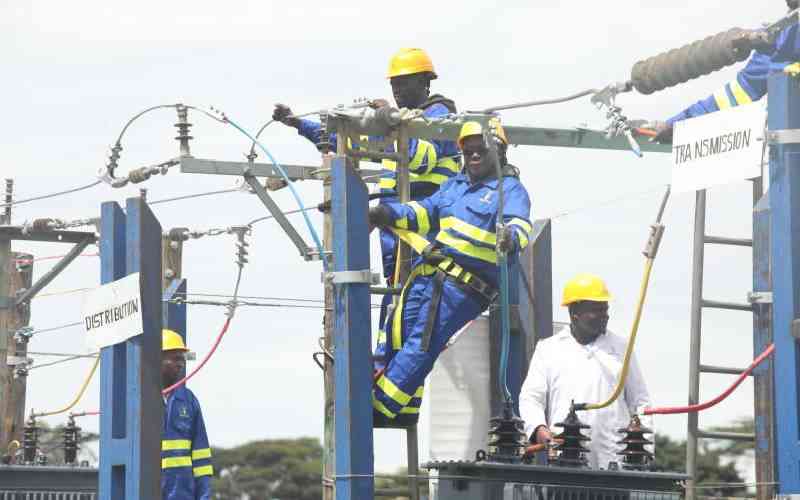
Revoke all the agreements that private power producers have signed with Kenya Power and move all power generation to State-owned agencies.
This, according to the Central Organisation of Trade Unions (Cotu), is what needs to happen for power prices to come down— a radical proposal and one unlikely to happen but perhaps that captures the frustration among Kenyans on the high cost of power.
A recent probe by Parliament found Kenya has some of the most expensive electricity in Africa, and this accounts for the high cost of production which acts as a disincentive to investment.
MPs had since April 2023 been probing the factors responsible for the high cost of power, one of the many inquiries with little having been achieved.
During the public participation phase, sector players and consumers gave their take on why power costs are high in Kenya and what can be done to lower them. Their sentiments are captured in a recent report that the Committee on Energy presented to Parliament in November.
It was during this process that Cotu boss Francis Atwoli said revoking the power purchase agreements (PPAs) that Kenya Power signed with independent power producers (IPPs) was necessary if electricity costs are to come down.
In his presentation, Atwoli also noted aged and poorly maintained power infrastructure, particularly transmission lines, are among the factors that are pushing the cost of power high.
The poor state of the country’s transmission infrastructure came up several times, with various submissions to the committee noting that this contributed to higher system losses and frequent blackouts, which play a part in pushing up the cost of electricity.
System losses, which are made up of technical losses and commercial losses, currently stand at 23 per cent, which means that out of every 100 units that Kenya Power buys from producers, 23 are lost before they are sold to consumers.
The cost of the losses is partly recovered from consumers (19.5 per cent) while Kenya Power covers the balance.
Technical losses occur during transmission with the actual losses determined by the state of the transmission infrastructure. Commercial losses are largely due to theft of power by consumers, who are at times aided by power sector employees.
Bringing down system losses to an acceptable rate of 14 per cent could save consumers billions, the committee was told.
Other factors that push up the cost of electricity that cropped up during the probe by MPs, which are captured in a report by the Committee, include high tax rates, where players appeared to point fingers at MPs for inaction.
Sector players noted that if the MPs were genuine in bridging down the cost of power, they should come up with legislation to lower taxes and levies that electricity consumers pay.
Atwoli told the committee that the government needed to tame IPPs who have negatively affected the cost of power in Kenya by making power more expensive, even if it meant doing away with them.
He noted that in addition to foreign currency-denominated PPAs exposing Kenyans to exchange rate risks, most IPPs also have tough and long-term contractual obligations that make it hard for any changes to be made even if market conditions or energy demand change.
“For the cost of electricity to be reduced, the Kenyan government must seek to have more control over costs and could potentially offer electricity at more competitive prices,” said Atwoli when he appeared before the committee.
“This can be done by revoking all PPAs that have been signed with various IPPs and instead engage KenGen or establish other state parastatals to handle electricity generation and supply.
“Having full control over the energy mix by prioritising the use of cheaper sources of energy, such as hydroelectric or geothermal power, (will) reduce overall costs,” he said.
The cost of electricity has since January 2024 been on the decline, dropping from a high of Sh36 per unit to current levels of about Sh28.
This is, however, still high compared to the Sh21 per unit that households were paying in August 2021 before the Kenya Kwanza regime took over and did away with a cheaper tariff that the Jubilee administration had pushed power sector agencies to implement through cutting waste.
Industries that made submissions to the committee demonstrated that it is possible to reduce the cost of electricity through initiatives such as cutting waste and reducing taxes.
Kenya Association of Manufacturers (KAM) policy and research manager Job Wanjohi told the committee that if Kenya Power, together with other electricity sector agencies, can reduce system losses to 14.5 per cent, it would save the customer on average Sh68 billion annually; from Sh19.331 billion to Sh13.11 billion.
KAM also noted that another way to lower costs for industries would be to let them buy power directly from producers and be billed at the generation tariff.
They would then pay for the transmission cost to Ketraco, which would transport the electricity to their premises.
Manufacturers can currently buy electricity directly from power producers following the enactment of the Energy Act 2019 but so far, this is only seen as being applicable when they set up industries in close proximity to the power plants. Such a scenario is envisaged with KenGen’s industrial park at Olkaria.
KAM also said there should be a legal provision to put margin or mark-up over and above aggregated generation tariff with the sole objective of driving operational and administrative efficiencies.
Wanjohi noted that by implementing the different suggestions by KAM including taming system losses, billing industries generational tariff and introducing the legal provision, the customer burden will be reduced by approximately Sh31 billion, translating to a reduction of Sh3 per unit.
He said there are no reasons for power costs to go up in the coming years. This is based on the fact that all power plants being onboarded will produce electricity using renewable energy and that there will be no additional thermal plants to warrant an increase in cost.
Energy sales are expected to grow year on year depending on economic growth and demand.
The Kenya Private Sector Alliance (Kepsa) also noted that to lower the cost of power, the government needed to take steps such as strengthening the grid and eliminating transmission bottlenecks, and operational efficiency at KPLC.
Kepsa also noted that the government should consider the extension of PPA tenures to spread the debt over a longer period for the respective IPPs to give lower generation prices, which can be passed to consumers.
According to Deputy Auditor General Fredrick Odhiambo, levies have contributed greatly in the pricing of electricity.
Among them are the rural electrification project levy that is set at five per cent of units consumed as well as value-added tax (VAT) of 16 per cent.
There are also the pass-through costs – the fuel cost charge and the foreign exchange adjustment – that vary every month and also account for a significant share of the power bill.
Other levies are the Energy and Petroleum Regulatory Authority (Epra) levy and the Water Resources Management Authority charges.
The Inter-Religious Council of Kenya also submitted that there is a need to reduce levies and taxes, which—together with the pass-through costs— currently account for 33.6 per cent of the power bill.
According to the council, fuel and taxes remain the two primary components that drive the cost of electricity high in Kenya and for power prices to come down the government should consider reducing by half all the levies and taxes on electricity.
Epra too observed that taxes and levies impact the overall cost of power and noted that mechanisms should be put in place to offer relief to consumers.
The energy industry regulator appeared to suggest that for power prices to come down, MPs have to act, noting that various taxes levied on electricity are anchored on various statutes which are passed by Parliament.
As the regulator, it noted that it implements policies in place and as such, whenever taxes are approved, it has to implement and pass the cost to consumers when developing the tariff.
The authority further said relief to consumers from the impact of these taxes and levies on the cost of power can be achieved through strategies such as subsidies and tax exemptions, which are to an extent within the mandate of MPs.
The Electricity Consumers Society of Kenya (Elcos) pointed to mobile money charges when purchasing power units as among the areas that indirectly push up the costs of power. Consumers pay over Sh300 million per month on these transactions.
Elcos executive director Isaac Ndereva said the process of purchasing prepaid tokens using mobile money, is “excessively one-sided in favour of someone other than the consumer”.
Elcos noted that Kenya is ranked 34 globally in the cost of electricity and was the second most expensive in Africa’s electricity cost ranking.
 The Standard Group Plc is a multi-media organization with investments in media platforms spanning newspaper print
operations, television, radio broadcasting, digital and online services. The Standard Group is recognized as a
leading multi-media house in Kenya with a key influence in matters of national and international interest.
The Standard Group Plc is a multi-media organization with investments in media platforms spanning newspaper print
operations, television, radio broadcasting, digital and online services. The Standard Group is recognized as a
leading multi-media house in Kenya with a key influence in matters of national and international interest.











